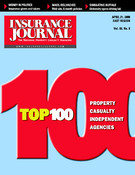A new driving simulation laboratory is now open for business in the University at Buffalo School of Engineering and Applied Sciences.
The state-of-the-art facility, housed in UB’s New York State Center for Industrial Design and Innovation, will be available for use by students, faculty and industry for research on automotive and flight vehicles, driver behavior, acclimation of accident victims suffering from post-traumatic stress disorder and even supplemental training of young drivers.
“This is one of a handful of motion simulator facilities in the U.S. and the only one within the State University of New York System,” said Kemper Lewis, Ph.D., executive director of NYSCEDII.
“The true power of our simulation facility is its ability to test a wide variety of roadway scenarios,” said Kevin Hulme, Ph.D., NYSCEDII research associate. “The marriage of large-screen visualization and six-degree-of-freedom motion cueing provides an efficient mechanism to conduct road-vehicle test studies, with a specific interest in improving transportation planning and roadway safety.”
The UB simulator consists of a “car” mounted on a six-degree-of-freedom motion base, donated by Moog Inc., which simulates the sensations of turning, braking and traveling up or downhill. The cabin is outfitted with a steering wheel and brake and clutch pedals. While the platform is moving, a 10-foot-by-8-foot display screen shows visualizations that simulate the “ride” the motion base passengers experience.
Funded by a $150,000 grant from the National Science Foundation, the simulator also has made it possible for UB to offer a unique course in which students can use the simulator to explore how design issues impact the physics and mechanics of vehicles.
One goal is to advance safer roadways. Hulme noted that roundabouts, also known as traffic circles, are becoming more common in an effort to reduce fatalities at intersections. “A lot of fatal accidents take place at intersections,” he said. “With our motion simulator, we can take a standard four-way intersection, press a button and the system graphically and physically simulates how traffic would change if it were a roundabout.”
The school’s researchers are developing visualizations that will allow users to simulate a variety of traffic conditions, such as inclement weather, nighttime driving, even motorcycle studies.
The simulator also would be ideal for training or testing new drivers, Hulme said, suggesting that it might be useful in supplementing the driver training programs offered by local driving clubs.
Was this article valuable?
Here are more articles you may enjoy.


 Surplus Lines Commercial Growth; Fla. Litigation Costs Reach New High in 2023
Surplus Lines Commercial Growth; Fla. Litigation Costs Reach New High in 2023  Insurers Settle With Hotel in Case of Woman Videotaped in the Shower
Insurers Settle With Hotel in Case of Woman Videotaped in the Shower  Man Admits to Tracking Drivers, Programming Keys, Stealing and Reselling Vehicles
Man Admits to Tracking Drivers, Programming Keys, Stealing and Reselling Vehicles  Allstate Reports Second Quarter Pretax Catastrophe Losses of $2.1B
Allstate Reports Second Quarter Pretax Catastrophe Losses of $2.1B 


